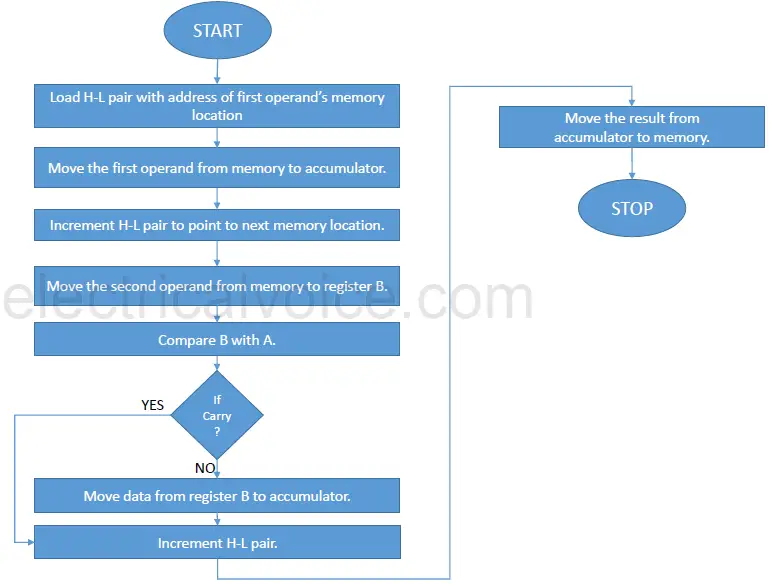Q. Write an 8085 program and draw a flowchart to find the Smallest of two 8-bit numbers.(8085 Microprocessor Program)
Flowchart/Algorithm

Program
| Address | Mnemonics | Operand | Opcode | Comments |
| 2000 | LXI | H, 3000H | 21 | Load H-L pair with address 3000H. |
| 2001 | 00 | |||
| 2002 | 30 | |||
| 2003 | MOV | A, M | 7E | Move the 1st operand from memory to reg. A. |
| 2004 | INX | H | 23 | Increment H-L pair. |
| 2005 | MOV | B, M | 46 | Move the 2nd operand from memory to reg. B. |
| 2006 | CMP | B | B8 | Compare B with A. |
| 2007 | JC | 200BH | DA | Jump to address 200BH if there is no carry. |
| 2008 | 0B | |||
| 2009 | 20 | |||
| 200A | MOV | A, B | 78 | Move smallest from reg. B to reg. A. |
| 200B | INX | H | 23 | Increment H-L pair. |
| 200C | MOV | M, A | 77 | Move the result from reg. A to memory. |
| 200D | HLT | 76 | Halt |
Output
Before Execution:
3000H: 25H
3001H: 15H
After Execution:
3002H: 15H
Program Explanation
- This program compares two operands to find the smallest out of them.
- After comparison, the smallest of two must be in the accumulator. If it is already in the accumulator, then it is moved to memory.
- If it is not in the accumulator, then first it is moved to the accumulator and then from there, it is moved to memory.
- Let us assume that the operands stored at memory location 3000H are 25H and 3001H is 15H.
- Initially, H-L pair is loaded with the address of first memory location.
- The first operand is moved to accumulator from memory location 3000H and H-L pair is incremented to point to next memory location.
- The second operand is moved to register B from memory location 3001H.
- The two operands are compared.
- After comparison, if A > B, then CF = 0, and if A < B, then CF = 1.
- Carry flag is checked for carry. If there is no carry, it means B is smaller than A and it is moved to the accumulator.
- At last, H-L pair is incremented and the smallest number is moved from the accumulator to memory location 3002H.
